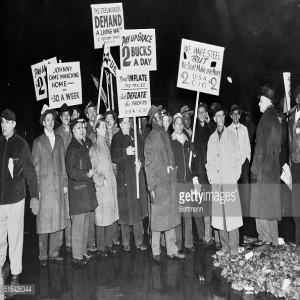
On this day in labor history, the year was 1941.
That was the day “The Battle at Bethlehem” began. 14,000 workers at Bethlehem Steel’s Lackawanna Mill in Buffalo, N.Y., walked out on strike.
The Steel Workers Organizing Committee, or SWOC, had been fighting to organize Little Steel for years.
‘Little Steel’ was a general term that referred to the smaller mills like Republic, Inland, Bethlehem and Youngstown Sheet & Tube.
At Bethlehem, SWOC was still waiting on a decision from the U.S. Court of Appeals about the company union Bethlehem refused to give up, in defiance of the Wagner Act.
As a defense industry, Bethlehem had $1.5 billion worth of armament orders to fill.
And yet, they wouldn’t even pay the legal minimum wage mandated for government contracts.
Retired steel worker, Mitchell Scheffer recalled in a 1991 interview, "I went to work there in the late 1930s swinging a 20-pound sledgehammer to break iron billets," says the 81-year-old. "I got 40 cents an hour, six days a week, no vacations"
The last straw was when Bethlehem fired over 1000 workers.
Bethlehem claimed these particular workers damaged coke ovens when they engaged in a work stoppage.
Workers immediately formed solid picket lines at seven gates that stretched two miles.
They successfully beat back attempts by police to scab herd.
After 38 hours, Bethlehem quickly agreed to reinstate the 1000 workers.
They soon resumed talks regarding wage increases, grievance procedures and union recognition.
But a month later, Bethlehem decided to go back on their promises.
They started organizing elections for collective bargaining representatives through their company union.
The stage was set for the next big strike at Bethlehem in March that would finally win union recognition.
More Episodes
 2022-09-05
2022-09-05
 2022-09-04
2022-09-04
 2022-09-03
2022-09-03
 2022-09-02
2022-09-02
 2022-08-31
2022-08-31
 2022-08-30
2022-08-30
 2022-08-29
2022-08-29
 2022-08-28
2022-08-28
 2022-08-27
2022-08-27
 2022-08-26
2022-08-26
 2022-08-25
2022-08-25
 2022-08-22
2022-08-22
 2022-08-21
2022-08-21
 2022-08-20
2022-08-20
 2022-08-18
2022-08-18
Create your
podcast in
minutes
- Full-featured podcast site
- Unlimited storage and bandwidth
- Comprehensive podcast stats
- Distribute to Apple Podcasts, Spotify, and more
- Make money with your podcast
It is Free
- Privacy Policy
- Cookie Policy
- Terms of Use
- Consent Preferences
- Copyright © 2015-2024 Podbean.com




